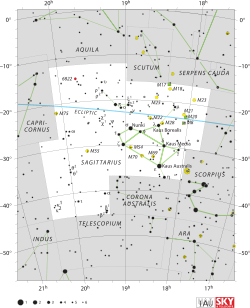Tau Sagittarii

Location of τ Sagittarii (circled) | |
| Observation data Epoch J2000.0 Equinox J2000.0 | |
|---|---|
| Constellation | Sagittarius |
| Right ascension | 19h 06m 56.40897s[1] |
| Declination | –27° 40′ 13.5189″[1] |
| Apparent magnitude (V) | +3.326[2] |
| Characteristics | |
| Spectral type | K1 III[3] |
| U−B color index | +1.185[2] |
| B−V color index | +1.170[2] |
| Astrometry | |
| Radial velocity (Rv) | +45.4[4] km/s |
| Proper motion (μ) | RA: –50.61[1] mas/yr Dec.: -249.80[1] mas/yr |
| Parallax (π) | 26.82 ± 0.86[1] mas |
| Distance | 122 ± 4 ly (37 ± 1 pc) |
| Details | |
| Radius | 16[5] R☉ |
| Surface gravity (log g) | 2.75[6] cgs |
| Temperature | 4,860[6] K |
| Metallicity [Fe/H] | –0.23[6] dex |
| Other designations | |
Tau Sagittarii (Tau Sgr, τ Sagittarii, τ Sgr) is a star in the southern zodiac constellation of Sagittarius.
Description
With an apparent visual magnitude of +3.3,[2] this is one of the brighter members of the constellation. The distance of this star from Earth is roughly 122 light-years (37 parsecs), based upon parallax measurements.[1]
This is a spectral type K1 giant star with 1.5 - 2 Solar masses. The stellar envelope is slightly cooler than the Sun, with an effective temperature of 4,860 K,[6] giving the star a light orange color. The interferometry-measured angular diameter of this star, after correcting for limb darkening, is 3.93 ± 0.04 mas,[8] which, at its estimated distance, equates to a physical radius of about 16 times the radius of the Sun.[5] Tau Sagittarii is a suspected double star although no companion has been confirmed yet. A lower metal content (Fe to H ratio is 70%) and a high peculiar velocity (64 km/s, 4x the local average) relative to the Sun suggest the star is a visitor from a different part of the Galaxy.
The Wow! Signal
Tau Sagittarii is the closest visible star in the night sky to the origin of the 1977 Wow! signal, the only radio signal that has been received that may be a sign of extraterrestrial intelligence. The location of the signal was, in epoch J2000.0 coordinates:
- Right ascension (on the positive horn): 19h 25m 31 ± 10s
- Right ascension (on the negative horn): 19h 28m 22 ± 10s
- Declination (the same for both horns): –26° 57 ± 20′
Name and etymology
- This star, together with :
- γ Sgr, δ Sgr, ε Sgr, ζ Sgr, λ Sgr, σ Sgr and φ Sgr, consisting the asterism Teapot.[9][10]
- φ Sgr, ζ Sgr, χ Sgr and σ Sgr were Al Naʽām al Ṣādirah (النعم السادرة), the Returning Ostriches.[11] According to the catalogue of stars in the Technical Memorandum 33-507 - A Reduced Star Catalog Containing 537 Named Stars, Al Naʽām al Ṣādirah or Namalsadirah was originally the title for four stars: φ Sgr as Namalsadirah I, τ Sgr as Namalsadirah II, χ1 Sgr as Namalsadirah III and χ2 Sgr as Namalsadirah IV (except σ Sgr and ζ Sgr).[12]
- ν Sgr, ψ Sgr, ω Sgr, 60 Sgr and ζ Sgr were Al Udḥiyy, the Ostrich's Nest.[11]
- In Chinese, 斗 (Dǒu), meaning Dipper, refers to an asterism consisting of τ Sagittarii, φ Sagittarii, λ Sagittarii, μ Sagittarii, σ Sagittarii and ζ Sagittarii. Consequently, σ Sagittarii itself is known as 斗宿五 (Dǒu Sù wu, English: the Fifth Star of Dipper.)[13]
References
- ↑ 1.0 1.1 1.2 1.3 1.4 1.5 van Leeuwen, F. (November 2007), "Validation of the new Hipparcos reduction", Astronomy and Astrophysics 474 (2): 653–664, arXiv:0708.1752, Bibcode:2007A&A...474..653V, doi:10.1051/0004-6361:20078357
- ↑ 2.0 2.1 2.2 2.3 Celis S., L. (October 1975), "Photoelectric photometry of late-type variable stars", Astronomy and Astrophysics Supplement Series 22: 9–17, Bibcode:1975A&AS...22....9C
- ↑ Gray, R. O. et al. (July 2006), "Contributions to the Nearby Stars (NStars) Project: spectroscopy of stars earlier than M0 within 40 pc-The Southern Sample", The Astronomical Journal 132 (1): 161–170, arXiv:astro-ph/0603770, Bibcode:2006AJ....132..161G, doi:10.1086/504637
- ↑ Wilson, R. E. (1953). General Catalogue of Stellar Radial Velocities. Carnegie Institute of Washington D.C. Bibcode:1953GCRV..C......0W.
- ↑ 5.0 5.1 Lang, Kenneth R. (2006), Astrophysical formulae, Astronomy and astrophysics library 1 (3 ed.), Birkhäuser, ISBN 3-540-29692-1. The radius (R*) is given by:
- ↑ 6.0 6.1 6.2 6.3 Jones, K. L. et al. (June 1992), "Spectroscopic investigation of cool giants and the authenticity of their reported microwave emission", Monthly Notices of the Royal Astronomical Society 256 (3): 535–544, Bibcode:1992MNRAS.256..535J
- ↑ "HD 177716 -- High proper-motion Star", SIMBAD Astronomical Object Database (Centre de Données astronomiques de Strasbourg), retrieved 2012-02-12
- ↑ Richichi; Percheron, I.; Khristoforova, M. (February 2005), "CHARM2: An updated Catalog of High Angular Resolution Measurements", Astronomy and Astrophysics 431: 773–777, Bibcode:2005A&A...431..773R, doi:10.1051/0004-6361:20042039
- ↑ "Sagittarius". deepsky.astroinfo.org. Retrieved 30 August 2008.
- ↑ skywatchers
- ↑ 11.0 11.1 Allen, R. H. (1963). Star Names: Their Lore and Meaning (Reprint ed.). New York: Dover Publications Inc. p. 355. ISBN 0-486-21079-0. Retrieved 2012-09-04.
- ↑ Jack W. Rhoads - Technical Memorandum 33-507-A Reduced Star Catalog Containing 537 Named Stars, Jet Propulsion Laboratory, California Institute of Technology; November 15, 1971
- ↑ (Chinese) AEEA (Activities of Exhibition and Education in Astronomy) 天文教育資訊網 2006 年 5 月 11 日
| ||||||||||||||||||||||||||
